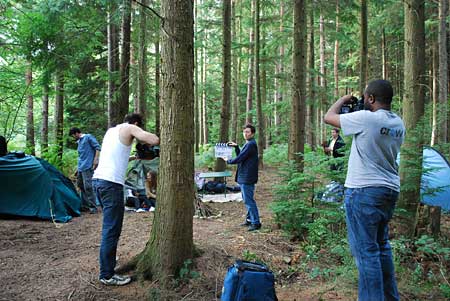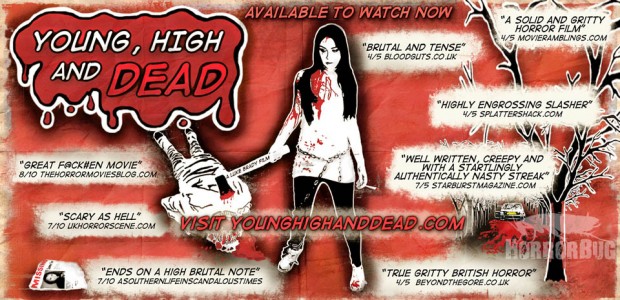
Luke Brady isn’t afraid to ruffle a few feathers (or, in the case of his film YOUNG, HIGH AND DEAD, shake a few branches) to make an impact. His latest film (which has just recently hit VOD) starts with the basic framework of a slasher film and then adds copious amounts of drugs, a smattering of pedophilia and a pinch of rape to just make the proceedings as grim and unpleasant as possible. Thankfully, he has a wonderful young cast that help to balance out some of the more horrific bits before things get messy, and the young actors get high.. and dead. Brady talked with Daily Grindhouse about his experiences making the film.
Sweetback (SB): Let’s start with the development of YOUNG, HIGH AND DEAD. This was your first listed feature. What is your background, and how did you go about raising funds for the film?
Luke Brady (LB): My background originally was special effects, I studied sfx at South Bank university and for my graduation piece iI made a short film. From this point, I steered my career in the direction of learning as much technical stuff as possible in the hope of eventually writing and directing my own work. For this reason the funding for YOUNG, HIGH AND DEAD wasn’t traditional. I knew the only way to get the film made and retain a decent level of control was to fund the project myself. This did mean I had to be extremely creative with how the money was spent.
SB: The film has three co-directors credited. How were the directing duties split up?
LB: To meet with the tight budget and even tighter schedule we devised a plan to allow us to pretty much shoot constantly. I directed the performances throughout the shoot and each of my Co directing team took it in turns behind camera, on sound and 1st AD’ing. So each of us took it in turns, framing the shots and visually bringing each scene to life. I still maintained overall control on how the film looked and sometimes jumped on camera myself, but by filming this way we kept our setups to an absolute minimum. On one day we shot about 16 pages of script, which was extremely fast paced.
LB: At the time I was running a casting studio in London so I had access to good talent and agents. Once the script was at a level where I felt comfortable, I started sending to agents. It helped that I worked with Robert Sterne who was able to advise and link me to some great people. The script seemed to go down really well amongst the actors that it was sent to and the cast was assembled quite quickly. The only problem we had was co-ordinating everyone’s diaries. If there were any reservations about the film being a slasher I certainly wasn’t made aware of it. The feedback on the script was very positive. Even though the film does have elements of horror/slasher to it, I think its equally dramatic and just as much about the characters as it is about an axe weilding psycho.
SB: The freedom of shooting in a forest can sometimes become a liability when trying to piece together interesting visuals. Was it a challenge to keep things visually interesting, particularly considering how much of the film sets-up the final twenty minutes?
LB: Absolutely, I spent months travelling all over the South of England visiting forest locations, but none of them worked. I was relaying my problems to my aunt who told me me about the forest she walks her dog in & said that it was very creepy looking and that i should check it out. The second I saw High Ridge I knew it would be perfect, the place gives me the creeps even during the day and every part of it is unique, each area has it’s own distinct look and feel, so for us the location really did a lot of the visual work for us.
SB: Some were turned off by the POV rape sequence in the film. How was it filmed, and what was your intention with putting the audience in the place of the rapist?
LB: scene really does unite or divide people in their opinions of YHAD. I watched a lot of rape revenge films for research and was astonished by how many of them sexualised both the act and the victim, this is especially true in so many modern ‘torture porn’ films. To shoot the scene I physically strapped the camera to my head, I knew that by forcing the audience to witness the rape through the eyes of the attacker the scene would be difficult to stomach. I didn’t expect so many people to react the way they did and I don’t regret shooting the scene that way. Regardless of whether people like or dislike that scene, it shows rape is about control and humiliation, not nudity and sex.
LB: The film definitely bubbles to boiling point for the main characters and the audience. I like to think this is because you really root for Jenny (played by Louisa Lytton) but it’s also a happy accident down to budget and schedule restraints. Both these restrictions forced the structure of the story this way, but we did shoot the last scenes on the last few days, so I do think there is an aggressive energy to a lot of the shots; perhaps a direct consequence of what happens when your crew is sleep deprived and stressed.
SB: The drug use of the main characters goes well beyond the pot-smoking you normally see in horror films. Was your intention to show characters acting like (some) people actually do, or was it a way to explain the sometime erratic actions of the characters?
LB: Both. Drug consumption often goes way beyond just smoking pot. Not that anyone ever wants to admit this, I wanted the drug and alcohol abuse in the film to be an obvious catalyst to most of the groups problems, despite the title of the film I didn’t want to glamorize the use of drink and drugs. I personally think the film doesn’t do this and hopefully the audience gets that.
SB: How much of the dialogue was scripted vs improvised? The actors really do a wonderful job making it look natural.
LB: The dialogue in the script got a lot of attention, I feel very comfortable writing lines for both sexes and in the early stages of the project I received a lot of compliments about this when people read the script. I did however allow the actors to adjust things if it wasn’t natural to them and we did do some improv. I think as long as the dialogue is relevant to each character then good actors will lift it off the page perfectly. My cast did a fantastic job of bringing the characters to life.

LB: I am indeed writing a sequel, I would love the chance to follow up the film with an even bigger budget and longer schedule. Even though I am extremely proud of my debut film, I know my next film will be even more intense and gory, I would like to go in even harder on the next shoot but right now I am only dealing at script level. I have 3 scripts that I am currently working on, all of which are very different in tone, genre and budget.
SB: For viewers interested in checking out YOUNG, HIGH AND DEAD, or keeping up on your future work, what’s the best way to do so?
Twitter is the main port of call, you can follow us @rumpunchprods or you can find us on most of the main social platforms just follow the links from our website which is www.younghighandead.com
SB: Anything else to promote?
LB: Just my podcast, I created series of episodes that go into more detail about each stage of the filmmaking processs with YHAD, its entirely free to download and is available on most podcast stores including iTunes.
SB: And, finally, what advice do you have for young or inexperienced directors trying to tackle their first feature?
LB: No one admits or tells you how emotional the journey is. You will have real highs and some epic lows. Making a feature film or long format project is extremely tough and it will bring you to the edge, the lows are very hard to deal with but are an essential part of the creative process, just never give up.
- [NO-BUDGET NIGHTMARES] PODCAST #80: PLAGA ZOMBIE (1997) - July 25, 2016
Tags: Dead, death, Dismemberment, gore, High, Horror, Rape, slasher, UK, Violent. Pedophilia, Young



No Comments